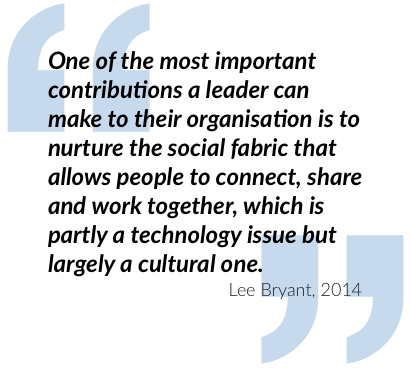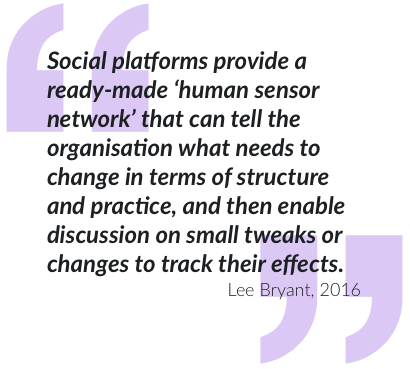Community
Digital Workplace Futures
Digital workplace tools enable employees to form influential connections no matter where they sit in the hierarchy, and in particular, to come together in communities of practice or interest.
Communities are a key part of the informal structures that enable work to get done, even in very hierarchical organisations, and one of the best aspect of the evolution of the digital workplace has been putting them on the map and giving them more visibility.
Over time, the digital workplace has gone from making it easier to find our connections, to demonstrating the value of communities, to becoming a strategic capability for transforming the organisation itself.
Perhaps the next stage will be to enable fluid community development across organisational boundaries, either between customers and employees or employees and the wider ecosystem their organisation is part of, including competitors.
> Introduction
> Technology
> Ownership
> Community
> Design
> Collaboration
> Skills
> Change Agents
> Leadership
> Org Structure
> Measurement
> Conclusion
- SHIFT 1: Connection
- SHIFT 2: Proving Value
- SHIFT 3: Strategic/Transformational
- NEXT: Cross-Border
- SHIFT 1: Connection
Early tools gave employees the ability to find and connect with previously unknown colleagues interested in similar topics for the first time. Communities of practice & interest were key to the earliest success stories.
However, early communities were hampered by an assumption of poor participation. There is a prevailing rule of thumb in external community management that only 1% of community members are active contributors. When you have communities at the scale of LinkedIn, this dynamic is to be expected. However, inside organisations, the other 99% of community participants are helping to create value though contributing, learning and growing the community. Encouraging participation in communities was found not to be enough – community managers had to help embed communities in the flow of work.
Communities of practice had long existed offline. They relied heavily on attracting people based on location or by who you already knew, rather than being able to reach the entire employee-base. Membership was often serendipitous. Suddenly, the ability to access everyone’s skills, interests and experience was available to all and has become a crucial pillar in changing the way organisations work.
Q2: When I realized it gave my ideas a totally unprecedented reach – something I would never have been able to get using emails & in-person meetings. Gave me scale and speed. #PS_Salon #DigitalWorkplace https://t.co/KFbcMZZN3b
— Celine Schillinger 🇺🇦 (@CelineSchill) April 5, 2019
- SHIFT 2: Proving Value
More visionary teams were creating communities to accelerate distributed or decentralised work. For example, forward-thinking finance teams using a community for collecting data inputs for budgeting, rather than relying on classic round-robin emails. Project management offices using a community of learning for spreading cutting edge developments in the field to project managers across the organisation. A motivated and enlightened leadership team inviting discussion of next years strategy in a safe setting.
But day-to-day, the organisation needed tips and tricks for successful community management at a smaller scale as the basis for spreading good practice across the organisation and creating a force multiplier for change.
Communities that are cultivated, curated and nurtured by community managers offer the best return on invested time for all employees and leaders. Community management has been a proven benefit at Bosch, where the formal community management structure, which includes training and qualifications, as well as a structured approach to measuring success has allowed key communities to become a lynchpin in the collaborative ways of working. Successful community management has more to do with personal attitude and experience than formal training, so best practice recipes and playbooks can only take an organisation so far.
- SHIFT 3: Strategic/Transformational
Communities are now valued as strategic drivers of organisational transformation. They are created to enable employees to raise, share and encourage local and global change actions. Through swapping ideas employees gain inspiration and insight for new experiments and innovations in products, services and new ways of working. These types of communities can also be used as a way to monitor progress towards transformational goals. Since digital transformation occupies a lot of attention at C-Suite level, communities that co-ordinate large-scale discussions about the future of work are high profile. They help highlight the resource needs of effective communities in terms of time, budget and executive attention.
We also see communities as the playground of emerging digital leaders – a place for them to hone their skills, develop expertise, practice influence and gain followers. As these future leader move up the organisational structures towards higher leadership roles, they will carry communities as a way of work with them, changing the way work flows at the most senior levels.
A6 #PS_Salon – To me the blending of „internal“ and „external“ is a big thing, tools supporting new partnerships among „frenemies“ and a #DigitalWorkplace easily inter-connecting individuals, start-ups, small enterprises and multinationals.
— Lukas Fütterer // @lukizzl@mastodontech.de (@lukizzl) April 5, 2019
- NEXT: Cross-Border
We are already seeing organisational boundaries become more porous in areas such as R&D, sales and technology teams. In the liminal space, between the technical border and the outside world, communities are the perfect structure to pull individuals with complimentary skillsets to achieve something unique and timely. This will require a new type of community, one that is temporary with varied membership and changing security requirements.
Employees at the edges of the organisation are likely to find that these collaborative experiences form a significant portion of their work and, indeed, produce much of their extrinsic motivation for work. Fast-moving, passion projects can help build alliances between unlikely partners, create ground-breaking opportunities and result in new organisational capabilities – cross-border communities are a prominent feature of the future of work!


